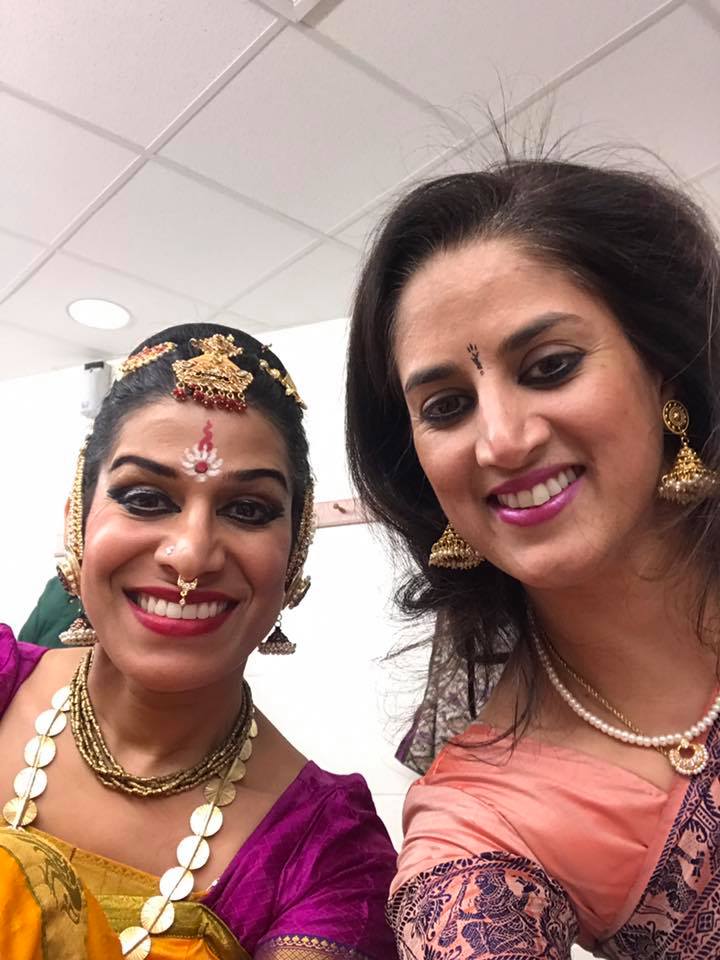Contribute
| TriNethra: The Third Eye Festival Of Dance |
Nithyani Anandakugan
01/04/2018
TriNethra: The Third Eye Festival of Dance By: Nithyani Anandakugan I began learning Bharatanatyam with Jayshree Akka in 2008 at age seven. Though at first attracted to dance by the makeup and costumes, I soon learned to appreciate it for its purity; in fact, I now view dance not only as an art form but also as a means of expression beyond standard convention. The Third Annual TriNethra Dance Festival that Jayshree Akka organized this past November reinforced this interpretation of dance that I have developed over the past nine years.
The TriNethra Dance Festival, put simply, is a platform for artistry. Through this event, Jayshree Akka has encouraged artists to authentically and sincerely showcase their diverse dance forms and styles. On Friday, November 17th, Jayshree Akka commenced the show with three young Kuchipudi dancers between the ages of twelve and sixteen: Sanjana Pulaparthi, Nandini Mandaloju, and Shamita Nookala. All students of Sailaja Chaudhary Tummala, the girls displayed their energy, technical finesse, and theatrical ability. They effectively captivated the audience with the story of Kuchela, a poor brahmin, who sought and received help from Krishna; they conveyed, through the story, socially-relevant themes of poverty and salvation.
The festival continued with Mohiniattam dancer Resmi Thekkedeth. Resmi, for me, embodied grace. Her enchanting quality transformed the auditorium’s atmosphere, and the lullaby that she performed reflected the very real experience between a mother and her child. Though open to creativity and ingenuity, dance finds its roots in reality and experience. Resmi certainly reinforced this central truth through her narrative and emotive capacity.
Jayshree Akka and the Bharathakalai Performing Troupe concluded Friday Night’s performances, accompanied by Janani Swamy’s vocals and Surya Sundararajan on the violin. They first demonstrated the Navarasas or nine emotions, followed by an exploration of the central characters of the Bharatanatyam narrative: the Nayikas. Bhavana Latha Vissapragada began as Yashodha, the doting mother. Sravani Kumar followed again as Yashoda—however, in this case, amazed by her child, Krishna. Manaswini Garimella then performed as the timid Nayika, shy and love-stricken. In contrast, Poorani Nallam Goundan then portrayed a bold Nayika. Nisha Nair proceeded with a forgiving Nayika, and Jayshree Acca followed with an opposing interpretation: the unforgiving Nayika. Together, the troupe skillfully and inventively epitomized the dramatic quality of dance in its ability to capture a variety of emotion and a breadth of narratives.
On Saturday, November 18th, the TriNethra Dance Festival opened with a Manipuri performance by Dr. Krishnakali Dasgupta. Through her performance, Krishnakali sampled the intricate and elaborate theatrical aspect to Manipuri by changing costumes to reflect the stories that she told. However, most memorably, Krishnakali showcased a distinctive characteristic to her style of Manipuri: she played the mridangam while dancing—an element of the dance form traditionally reserved for men. As a pioneer in Manipuri, Krishnakali has expanded the the dance form’s horizons; in so doing, she has helped it evolve with our times.
The dance festival concluded with a performance by Mesma Belsaré. Her performance was unequivocally unique and unparalleled. Mesma forges her own style of Bharatanatyam from the familiar techniques and basics typically associated with the dance form. Her presentation, NÄtyamekhalÄ, offered a novel perspective on the Buddhist and Hindu icons typically portrayed in classical Indian dance forms. Mesma closed the night with a stunning depiction of ArdhanÄrÄ«shwara, the half-man and half-woman form of Shiva, through which she highlighted both the duality and harmony in humanity. With her profoundly contemporary and untraditional style of Bharatanatyam, Mesma shared with us an interpretation of dance that is characteristically her own. The audience received her with a standing ovation—a well-deserved one at that.
The TriNethra Festival of Dance certainly fulfilled its objective: it inspired innovative artistry in various traditional dance forms. Yet, most importantly, the festival provided a platform for dancers—one that allowed them to dance simply for the sake and spirit of dance.
You may also access this article through our web-site http://www.lokvani.com/
